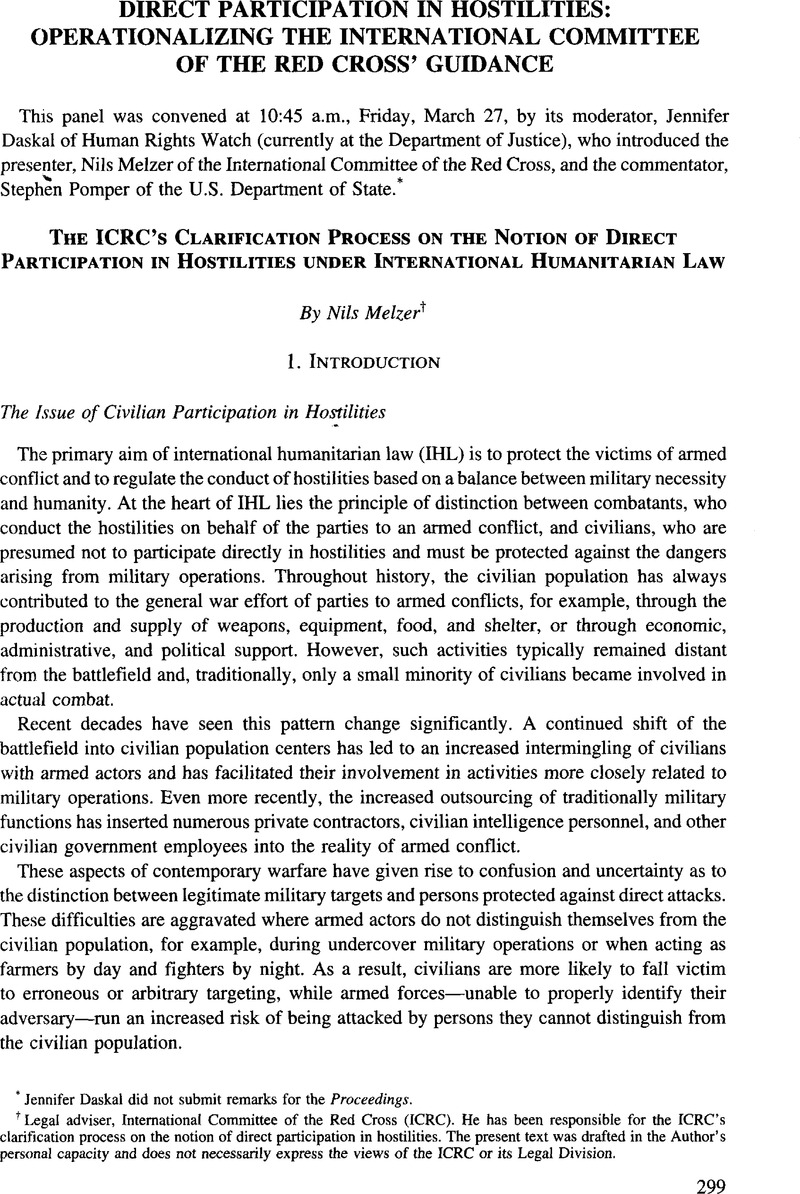Article contents
The ICRC’s Clarification Process on the Notion of Direct Participation in Hostilities Under International Humanitarian Law
Published online by Cambridge University Press: 28 February 2017
Abstract

- Type
- Direct Participation in Hostilities: Operationalizing the International Committee of the Red Cross’ Guidance
- Information
- Copyright
- Copyright © American Society of International Law 2009
References
1 According to an undisputed rule of customary and treaty IHL, civilians must be protected against the dangers arising from military operations, and particularly against direct attack, “unless and for such time as they take a direct part in hostilities.” See First Protocol Additional to the Geneva Conventions of 1949, art. 51(3), June 8, 1977, 1125 U.N.T.S. 3 [hereinafter Ap I]; Second Protocol Additional to the Geneva Conventions of 1949, art. 13(3), June 8, 1977, 1125 U.N.T.S. 607 [hereinafter Ap II]. See also Henckaerts & Doswald-Beck, 1 Customary International Humanitarian Law, Rule 6 (2005) [hereinafter Customary IHL].
2 The expert meetings were held in the Hague on June 2, 2003 and Oct. 25-26, 2004, as well as in Geneva on Oct. 23-25, 2005, Nov. 27 & 28, 2006, and Feb. 5-6, 2008. A comprehensive overview of the discussions and of the wide variety of views expressed during the expert meetings is provided in separate expert meeting reports (see infra note 3).
3 The ICRC’s “Interpretive Guidance on the Notion of Direct Participation in Hostilities under International Humanitarian Law” (hereinafter “Interpretive Guidance”), along with the complete proceedings of the expert process, are available online on the ICRC’s website (www.icrc.org).
4 The ICRC’s Interpretive Guidance consists of ten recommendations, each of which summarizes the ICRC’s position on the interpretation of IHL on a particular legal question, and an accompanying commentary explaining the legal and argumentative bases of each recommendation.
5 For the ICRC’s position on this issue, see Interpretive Guidance, supra note 3, sections I to III.
6 See AP I, supra note 1, art. 50(1); Customary IHL, supra note 1, Rule 5. See also ICRC, Commentary on the Additional Protocols of 8 June 1977 to the Geneva Conventions of 12 August 1949 §1916 (Sandoz et al. eds., 1987) [hereinafter Commentary AP]; Prosecutor v. Blaskic, Case No. IT-95-14-T, Judgment, § 180 (Intl. Crim. Trib. For the Former Yugoslavia Mar. 3, 2000).
7 See Ap I, supra note 1, art. 43(1); Customary IHL, supra note 1, Rule 4.
8 Hague Regulations, art. 2, Oct. 18, 1907, 36 Stat. 2277 [hereinafter Hague Regulations]; also referred to in AP 1, supra note 1, art. 50(1).
9 See Customary IHL, supra note 1, at 19.
10 For the ICRC’s position on this issue, see Interpretive Guidance, supra note 3, section II. See also Prosecutor v. Martić, Case No. IT-95-11-A, Judgment, §§ 300-302 (Int’l Crim. Trib. for the Former Yugoslavia Oct. 8, 2008).
11 For the ICRC’s position on this issue, see Interpretive Guidance, supra note 3, sections IV to VI.
12 See AP I, supra note 1, art. 35(1) and, similarly, Hague Regulations, supra note 8, art. 22.
13 See AP I, supra note 1, arts. 43(2), 45(1) and (3), 51(3), 67(l)(e); AP II, supra note 1, art. 13(3).
14 As evidenced by the consistent use of the term “participent directement” in the equally authentic French versions of the relevant treaty texts, the terms “active” (art. 3 GC I-IV) and “direct” (arts. 51(3), 43(2), 67(l)(e) AP I; 13(3) AP II) used in the English treaty texts refer to the same quality and degree of individual participation in hostilities. See also Prosecutor v. Akayesu, Case No. ICTR-96-4-T, Judgment, § 629 (Sept. 2, 1998).
15 See also Commentary AP, supra note 6, §§ 1679, 1945. Affirmative also Prosecutor v. Strugar, Case No. IT-01-42-A, Judgment, §§ 175-176 (Int’l Crim. Trib. for the Former Yugoslavia July 17, 2008).
16 See also Commentary AP, supra note 6, §§ 1679, 1944, 4787.
17 The requirement of belligerent nexus refers to the relation between an act and the conduct of hostilities between the parties to an armed conflict and, therefore, is conceived more narrowly than the general nexus requirement developed in the jurisprudence of the ICTY and the ICTR as a precondition for the qualification of an act as a war crime, which refers to the relation between an act and a situation of armed conflict as a whole.
18 Direct attacks against persons and objects protected against direct attack are prohibited under IHL. The use of force by civilians not exceeding what is necessary and proportionate to defend themselves or others against such unlawful attacks lacks belligerent nexus and, therefore, does not amount to direct participation in hostilities.
19 For the ICRC’s position on this issue, see Interpretive Guidance, supra note 3, sections VII to X.
20 See Hague Reguhtions, supra note 8, art. 22; AP I, supra note 1, art. 35.
21 For concrete examples illustrating the relevance of considerations of military necessity and humanity in determining the kind and degree of permissible force against legitimate miltiary targets, see Interpretive Guidance, supra note 3, section IX.2.
- 12
- Cited by




